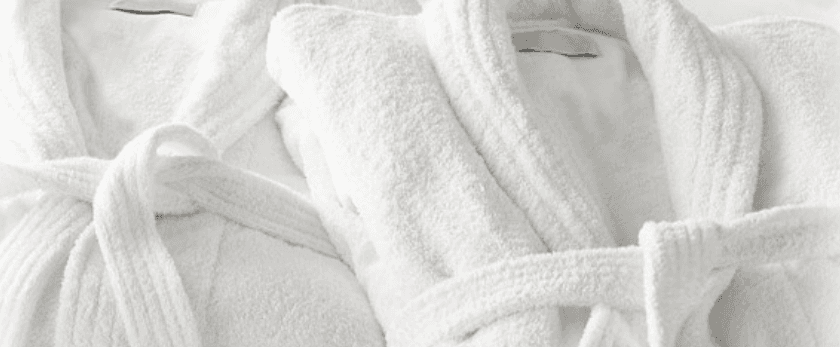Welcome to the world of sustainable living! In today's fast-paced world, it's easy to get caught up in the convenience of disposable products. However, these products often have a negative impact on the environment, contributing to pollution and waste. One such item is the bathrobe, a staple in many households. But did you know that making your own bathrobe can be a simple and eco-friendly solution? In this article, we'll explore why the traditional bathrobe is bad for the environment and how making your own can be a better alternative. We'll also provide you with a step-by-step guide on how to make your own homemade bathrobe. So let's get started!
Why the Traditional Bathrobe is Bad for the Environment
-
Made from Synthetic Materials: Most bathrobes available in the market are made from synthetic materials such as polyester, nylon, and acrylic. These materials are derived from non-renewable resources and require a significant amount of energy to produce. Additionally, they do not biodegrade and can take hundreds of years to decompose, contributing to the growing problem of plastic pollution.
-
Chemical Dyes and Finishes: The vibrant colors and soft texture of traditional bathrobes are achieved through the use of chemical dyes and finishes. These chemicals can be harmful to the environment, as they can leach into water bodies and harm aquatic life. They can also be harmful to human health, causing skin irritation and respiratory problems.
-
Packaging and Shipping: Bathrobes are often packaged in plastic and shipped long distances, resulting in a significant carbon footprint. This adds to the already existing problem of greenhouse gas emissions, contributing to climate change.
-
Disposal: When bathrobes reach the end of their lifespan, they are often disposed of in landfills, where they take up valuable space and release harmful chemicals into the environment as they decompose. This not only contributes to pollution but also wastes valuable resources.
Why Making Your Own Bathrobe is Better for the Environment
-
Use of Sustainable Materials: By making your own bathrobe, you have control over the materials used. You can opt for sustainable and eco-friendly materials such as organic cotton, bamboo, or linen. These materials are renewable, biodegradable, and require less energy to produce.
-
Natural Dyes and Finishes: Instead of using chemical dyes and finishes, you can opt for natural alternatives such as plant-based dyes and essential oils. These are not only better for the environment but also for your health.
-
Reduced Carbon Footprint: Making your own bathrobe means you can source materials locally, reducing the carbon footprint associated with packaging and shipping. You can also choose to upcycle old fabrics or repurpose materials, further reducing your environmental impact.
-
Responsible Disposal: When your homemade bathrobe reaches the end of its lifespan, you can dispose of it responsibly by composting or recycling it. This ensures that the materials are not wasted and can be reused in some form.
What You'll Need
- Fabric of your choice (organic cotton, bamboo, linen, etc.)
- Sewing machine or needle and thread
- Scissors
- Measuring tape
- Pins
- Iron
- Natural dyes (optional)
- Essential oils (optional)
Directions
-
Measure and Cut the Fabric: Start by measuring yourself or the person you're making the bathrobe for. You'll need to measure the length from the shoulders to the desired length of the bathrobe, as well as the width of the shoulders and the circumference of the waist. Add a few inches to these measurements for seam allowance. Once you have your measurements, lay out the fabric and cut it to the desired length and width.
-
Sew the Shoulders: Fold the fabric in half lengthwise and sew the shoulders together, leaving a gap for the neck. You can use a sewing machine or hand sew using a backstitch. Once done, turn the fabric right side out.
-
Sew the Sides: With the fabric still inside out, sew the sides together, leaving gaps for the arms. You can try on the bathrobe at this point to ensure it fits comfortably.
-
Add Sleeves (Optional): If you want to add sleeves to your bathrobe, you can cut out two rectangles of fabric and sew them onto the arm gaps. Alternatively, you can leave the arm gaps open for a more relaxed fit.
-
Hem the Edges: Hem the edges of the bathrobe by folding the fabric over twice and sewing it in place. This will give your bathrobe a neat and finished look.
-
Add Pockets (Optional): If you want to add pockets to your bathrobe, cut out two rectangles of fabric and sew them onto the front of the bathrobe. You can also add a belt or tie at this point if desired.
-
Natural Dye and Finish (Optional): If you want to add some color to your bathrobe, you can use natural dyes such as turmeric, beetroot, or onion skins. Follow the instructions on the dye package to achieve your desired color. You can also add a few drops of essential oils to the final rinse for a pleasant scent.
-
Iron and Enjoy: Once your bathrobe is complete, give it a final ironing to smooth out any wrinkles. Your homemade bathrobe is now ready to be enjoyed!
Conclusion
Making your own bathrobe is not only a fun and creative activity, but it also has a positive impact on the environment. By using sustainable materials, natural dyes, and responsible disposal methods, you can reduce your carbon footprint and contribute to a greener, more eco-friendly lifestyle. So why not give it a try and make your own homemade bathrobe today? Your planet and your wallet will thank you.










